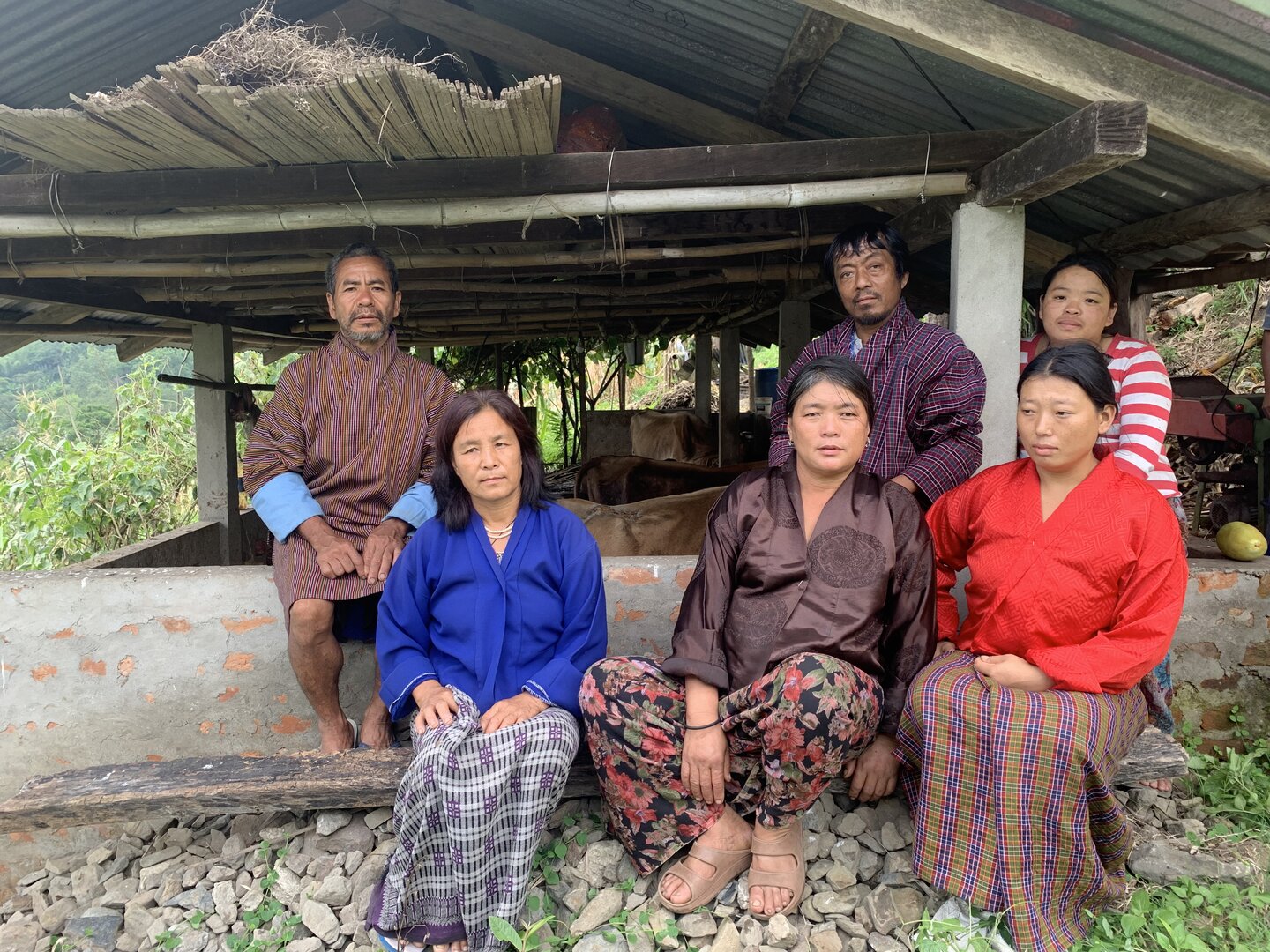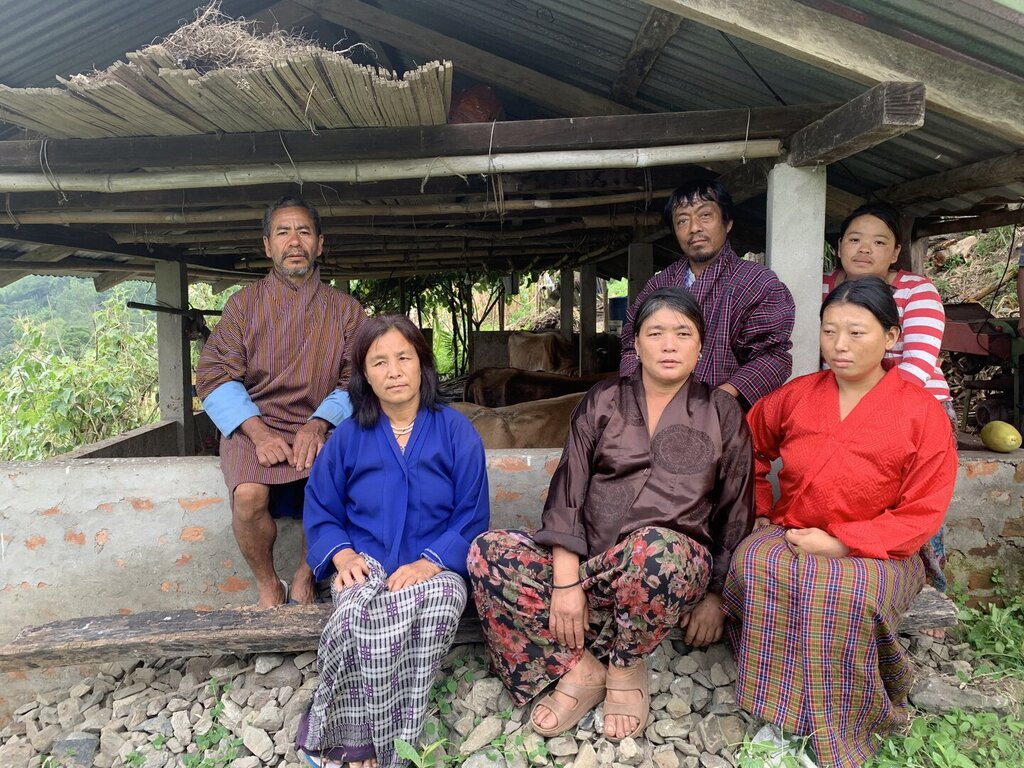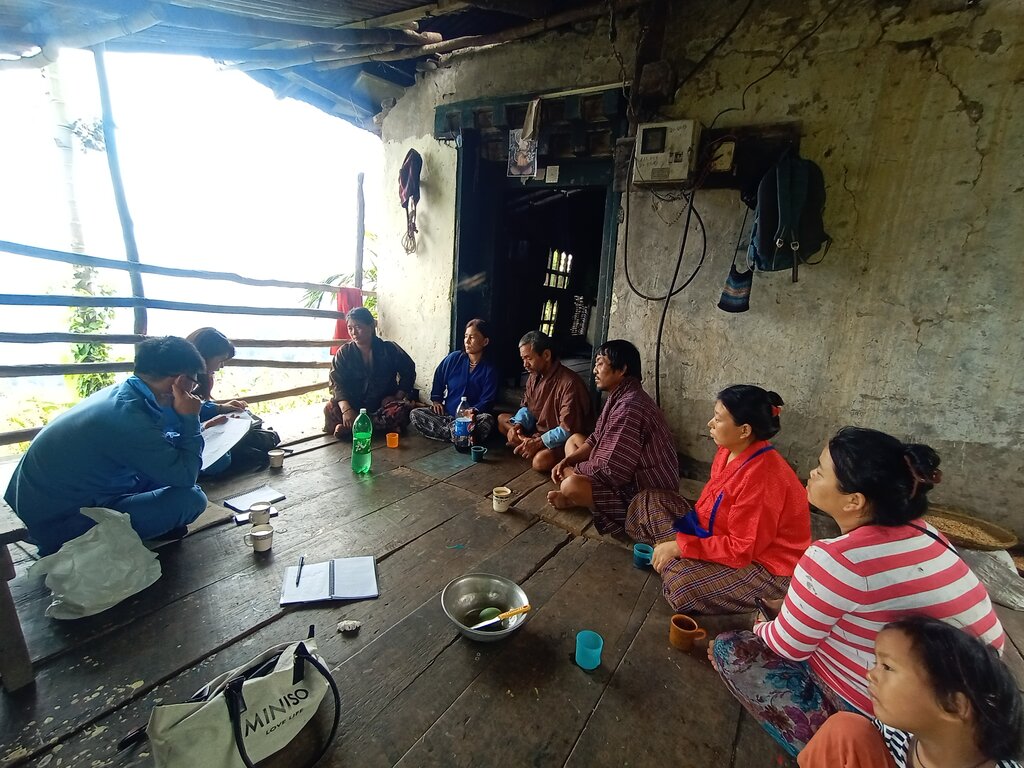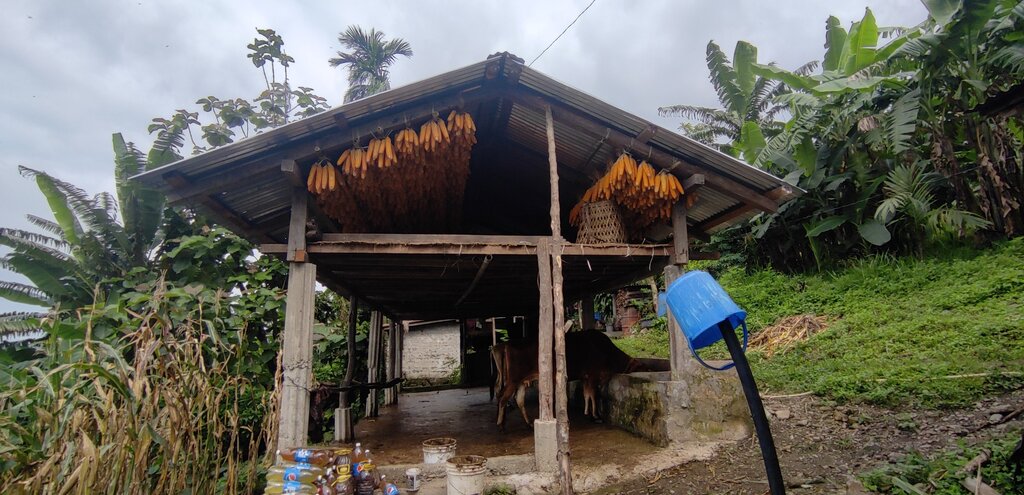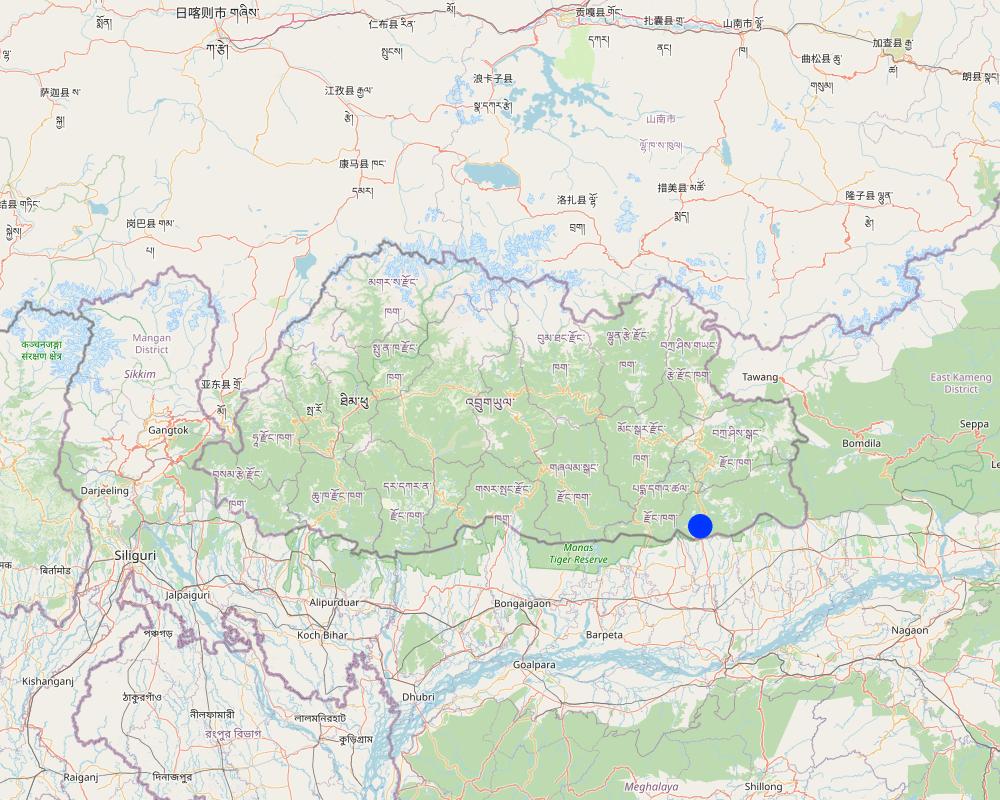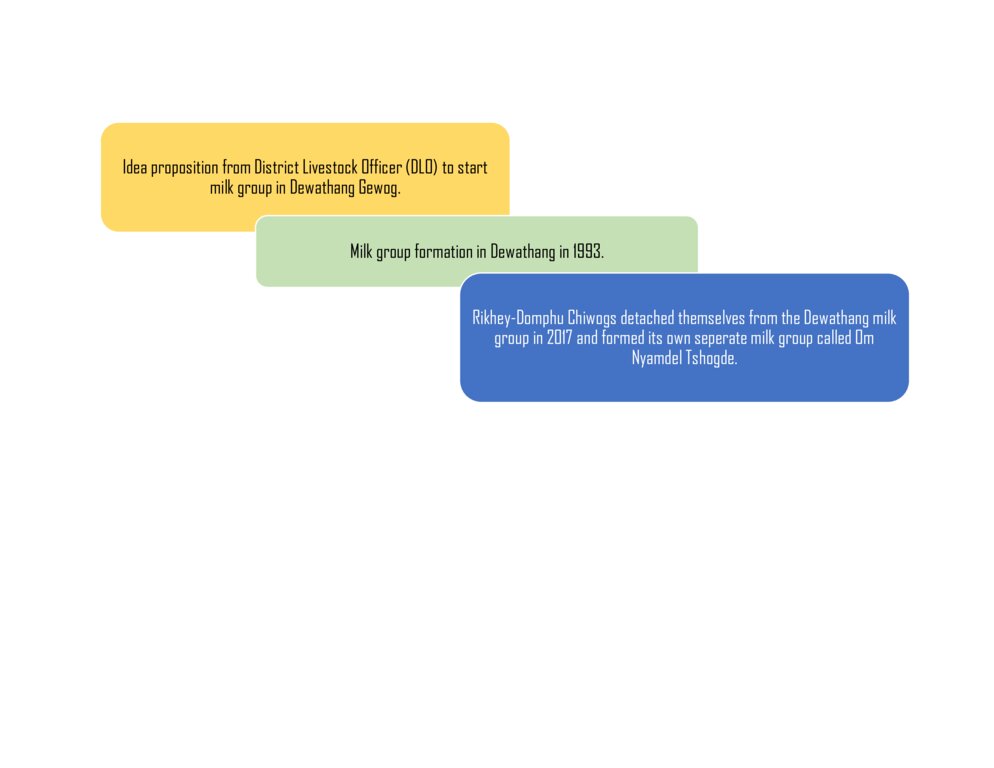Improved Livestock Farming System [Bhutan]
- Creation:
- Update:
- Compiler: Tshering Yangzom
- Editor: chenga Tshering
- Reviewers: William Critchley, Rima Mekdaschi Studer
approaches_6895 - Bhutan
View sections
Expand all Collapse all1. General information
1.2 Contact details of resource persons and institutions involved in the assessment and documentation of the Approach
Key resource person(s)
land user:
Yangzom
17410001
Kheripam village, Domphu chiwog, Dewathang gewog, Samdrup Jongkhar Dzongkhag
Bhutan
land user:
Zangmo Tshewang
17967451
Kheripam village, Domphu chiwog, Dewathang gewog, Samdrup Jongkhar Dzongkhag
Bhutan
land user:
Wangdi
Kheripam village, Domphu chiwog, Dewathang gewog, Samdrup Jongkhar Dzongkhag
Bhutan
land user:
Jampel
17940948
Kheripam village, Domphu chiwog, Dewathang gewog, Samdrup Jongkhar Dzongkhag
Bhutan
land user:
Zangmo Tendel
17970719
Kheripam village, Domphu chiwog, Dewathang gewog, Samdrup Jongkhar Dzongkhag
Bhutan
land user:
Wangmo Cheki
17569913
Kheripam village, Domphu chiwog, Dewathang gewog, Samdrup Jongkhar Dzongkhag
Bhutan
Name of project which facilitated the documentation/ evaluation of the Approach (if relevant)
Strengthening national-level institutional and professional capacities of country Parties towards enhanced UNCCD monitoring and reporting – GEF 7 EA Umbrella II (GEF 7 UNCCD Enabling Activities_Umbrella II)Name of the institution(s) which facilitated the documentation/ evaluation of the Approach (if relevant)
National Soil Services Center, Department of Agric (National Soil Services Center, Department of Agric) - Bhutan1.3 Conditions regarding the use of data documented through WOCAT
When were the data compiled (in the field)?
09/07/2023
The compiler and key resource person(s) accept the conditions regarding the use of data documented through WOCAT:
Yes
1.4 Reference(s) to Questionnaire(s) on SLM Technologies
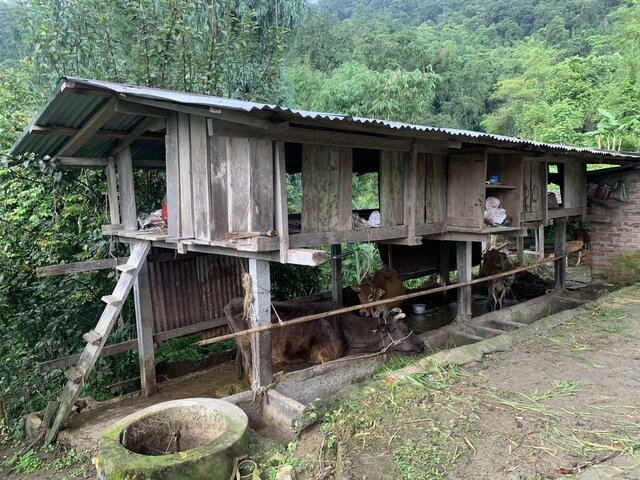
Improved Dairy Shed [Bhutan]
An improved dairy shed in Bhutan is characterized by concrete floors, cement pillars and troughs, enough sunlight and ventilation, adequate water, ample space for cattle movement, as well as urine and dung collection gutters and a farmyard manure collection area.
- Compiler: Tshering Yangzom
2. Description of the SLM Approach
2.1 Short description of the Approach
The approach involves a group of farmers implementing an improved dairy system. The system incorporates practices and technologies that enhance animal welfare, reduce environmental impact, and increase production.
2.2 Detailed description of the Approach
Detailed description of the Approach:
This case describes how a group approach can facilitate and encourage improved dairy production with better sheds, more productive breeds, environmental sustainability and marketing. Upgraded dairy production is described in detail under the technology “Improved dairy sheds” (T6898).
Initially, the land users were a part of a bigger milk group established in 1993. In 2017, some detached themselves and formed “Om Nyamdel Tshogde” which is a group composed of 67 members from Rikhey and Domphu chiwogs, led by a Chairperson, Mrs. Yangzom. The group also has a treasurer, Drungchen, and a driver. The main objective of forming the milk group was to improve the livelihoods of land users through higher yields via better livestock farming. The group formation process was assisted by the livestock extension officer. The funding was mobilized from the community itself.
The group members, with some support from the government, constructed improved dairy sheds, and biogas plants, and received training on fodder plantations. The stakeholders involved were land users, livestock extension officers, and the private cooperative B-COOP. The land users' role is to coordinate and conduct activities related to livestock farming. The extension officer's role is to provide veterinary and technical services. B-COOP's role is to buy dairy products from the group, especially milk.
The group members have installed improved dairy sheds with cemented floors, feeding troughs, corrugated galvanised iron (CGI) roofing, and a continuous water supply. Also, cattle have access to timely veterinary services. Cow dung and urine are used as fertilizers and also in biogas plants. Biogas plants generate renewable energy (methane), thereby cutting down the use of liquefied petroleum gas (LPG) gas which is derived from fossil fuel.
Under improved dairy sheds, stall-feeding is practised which bars the cattle from going to forests to feed. This prevents the degradation of land by cattle movement through trampling. For better nutrition and feeding, grass fodder species including Super Napier (pakchung), Napier, and Guatemala are grown, cut and and fed to cattle. In addition, other feeds provided included banana stems, maize stems, maize powder, mustard cake, and processed feeds. The group delivers at least 300 litres of milk per day to B-COOP, and some milk goes to India.
Improved breeds have replaced numerous low-yielding local cattle thereby making more efficient use of cattle feed. Also, fewer, more productive animals help reduce environmental degradation and methane losses to the atmosphere. The majority of cattle reared have been bred through artificial insemination. Most cattle are 50:50 hybrids between local breeds and improved breeds such as Jersey. Improving the breeds helps to increase milk production (e.g Holstein Friesian) and or percentage butter fat (e.g. Jersey). To feed and sustain productive, improved breeds, various fodder species are cultivated in large areas. This helps in carbon sequestration and preventing soil erosion.
What the land users like about the approach is that improved livestock farming results in a continuous source of income, as milk production is not seasonal like vegetable production, it provides organic fertilizers for fields, improves livelihoods, makes use of waste such as cow dung in biogas plants which means reduced dependency on LPG gas which is quite expensive. Also access to credit is increased. Government support has increased after the milk group formation. Furthermore, the workload is shared among the land users, especially during the making of biogas plants, thus easing the workload per person.
2.3 Photos of the Approach
2.4 Videos of the Approach
Comments, short description:
Cattle feeding inside an improved dairy shed
https://youtu.be/ZxV-PbV6UXY
Date:
09/07/2023
Location:
Kheripam village, Domphu chiwog, Dewathang gewog, Samdrup Jongkhar Dzongkhag
Name of videographer:
Nima Dolma Tamang
2.5 Country/ region/ locations where the Approach has been applied
Country:
Bhutan
Region/ State/ Province:
Kheripam village, Domphu chiwog, Dewathang gewog, Samdrup Jongkhar Dzongkhag
Map
×2.6 Dates of initiation and termination of the Approach
Indicate year of initiation:
2017
Comments:
The approach is ongoing with no fixed termination date. The approach shall continue as long as it seems to help the land users.
2.7 Type of Approach
- recent local initiative/ innovative
2.8 Main aims/ objectives of the Approach
The main aims of the approach are to enhance the overall well-being of animals, optimize animal production, minimize forest grazing and promote continuous stall feeding, increase the availability of FYM and urine for application to fields, develop pasture with fodder grasses, foster efficient waste utilization, provide a comfortable working environment for land users, and improve the livelihoods of land users through higher yields and better household income.
2.9 Conditions enabling or hindering implementation of the Technology/ Technologies applied under the Approach
availability/ access to financial resources and services
- enabling
There is assured monthly income for the land users due to the supply of milk to B-COOP and India.
institutional setting
- enabling
There is assured monthly income for the land users due to the supply of milk and other dairy products to B-COOP and India. This has helped improve the livelihoods of land users through higher yields and better household income.
collaboration/ coordination of actors
- enabling
There is labour sharing in the group (for example in the construction of biogas plants) thereby easing the workload in the group. The milk group is collectively run by the land users. Every land user is equally involved in meetings related to the group. The land users also share experiences and ideas, resulting in continuous improvement. All these enhance collaboration/coordination among the land users.
policies
- enabling
The government has supported the land users by providing deep freezers and other livestock farming construction materials free of cost.
knowledge about SLM, access to technical support
- enabling
The land users realize the importance of improved livestock farming systems and biogas plants. They also have access to advisory services from the livestock extension officer.
markets (to purchase inputs, sell products) and prices
- enabling
The group sells dairy products to Bhutan (B-COOP) and India, especially milk and generates income. The group has access to different markets which might have been difficult for individual farmers to have access to.
workload, availability of manpower
- enabling
There is labour-sharing in the group (for example in the construction of biogas plants) thereby easing the workload in the group.
3. Participation and roles of stakeholders involved
3.1 Stakeholders involved in the Approach and their roles
- local land users/ local communities
The land users of Rikhey-Domphu chiwogs.
Collectively produce milk (at least 300 L/day).
- SLM specialists/ agricultural advisers
Livestock extension officer.
Provide technical support to land users.
- private sector
Bhutan Cooperative (B-COOP)
Buy milk from the group.
3.2 Involvement of local land users/ local communities in the different phases of the Approach
| Involvement of local land users/ local communities | Specify who was involved and describe activities | |
|---|---|---|
| initiation/ motivation | external support | The livestock extension officer proposed the formation of the milk group. |
| planning | interactive | The livestock officer and land users planned the group management plan. |
| implementation | self-mobilization | The land users carried out the fieldwork of producing milk and constructing improved dairy sheds and biogas plants. |
| monitoring/ evaluation | self-mobilization | The land users monitor their group activities. |
3.3 Flow chart (if available)
3.4 Decision-making on the selection of SLM Technology/ Technologies
Specify who decided on the selection of the Technology/ Technologies to be implemented:
- mainly land users, supported by SLM specialists
Explain:
Mainly land users supported by the livestock officer.
Specify on what basis decisions were made:
- evaluation of well-documented SLM knowledge (evidence-based decision-making)
4. Technical support, capacity building, and knowledge management
4.1 Capacity building/ training
Was training provided to land users/ other stakeholders?
Yes
Specify who was trained:
- land users
If relevant, specify gender, age, status, ethnicity, etc.
Both male and female.
Form of training:
- farmer-to-farmer
- demonstration areas
- public meetings
Subjects covered:
-Biogas plant construction
-Fodder grass plantation
4.2 Advisory service
Do land users have access to an advisory service?
Yes
Specify whether advisory service is provided:
- on land users' fields
- at permanent centres
Describe/ comments:
The land users have access to advisory services from the livestock extension agent.
4.3 Institution strengthening (organizational development)
Have institutions been established or strengthened through the Approach?
- yes, greatly
Specify the level(s) at which institutions have been strengthened or established:
- local
Describe institution, roles and responsibilities, members, etc.
There is assured monthly income for the land users due to the sell of milk and other dairy products such as cheese and butter.
Specify type of support:
- financial
4.4 Monitoring and evaluation
Is monitoring and evaluation part of the Approach?
Yes
If yes, is this documentation intended to be used for monitoring and evaluation?
No
4.5 Research
Was research part of the Approach?
No
5. Financing and external material support
5.1 Annual budget for the SLM component of the Approach
If precise annual budget is not known, indicate range:
- < 2,000
Comments (e.g. main sources of funding/ major donors):
There is no annual budget allocated for the construction of improved dairy sheds and biogas plants. For biogas plant construction, pipes, metals, and 15 bags of cement were provided to land users by the government. For dairy shed construction, roofing material (18 CGI sheets) and 18 bags of cement were provided. These materials were provided by the government only once. There is no annual providing of materials or money to the land users.
5.2 Financial/ material support provided to land users
Did land users receive financial/ material support for implementing the Technology/ Technologies?
Yes
If yes, specify type(s) of support, conditions, and provider(s):
For biogas plant construction, pipes, metals, and 15 bags of cement were provided to land users by the government. For dairy shed construction, roofing material (18 CGI sheets) and 18 bags of cement were provided. Also, deep freezers were provided to the land users.
5.3 Subsidies for specific inputs (including labour)
- equipment
| Specify which inputs were subsidised | To which extent | Specify subsidies |
|---|---|---|
| fully financed | Deep freezers | |
- construction
| Specify which inputs were subsidised | To which extent | Specify subsidies |
|---|---|---|
| partly financed | Cement bags CGI sheets Pipes Metals A part of these materials was financed by the government. | |
If labour by land users was a substantial input, was it:
- voluntary
5.4 Credit
Was credit provided under the Approach for SLM activities?
Yes
Specify conditions (interest rate, payback, etc.):
Nu 20,000 credit
Specify credit providers:
BDBL
Specify credit receivers:
Land users
5.5 Other incentives or instruments
Were other incentives or instruments used to promote implementation of SLM Technologies?
No
6. Impact analysis and concluding statements
6.1 Impacts of the Approach
There is assured monthly income for the land users due to the sale of milk and this has empowered them to produce more milk to earn more money. There is labour sharing in the group (for example in the construction of biogas plants) thereby easing the workload in the group. The milk group is collectively run by the land users. Every land user is equally involved in meetings related to the group. The land users also share experiences and ideas, resulting in continuous improvement. All these enhance collaboration/coordination among the land users (stakeholders).
There is assured monthly income for the land users due to the sale of milk and this has enabled the land users to continue with stall feeding practices and pasture establishment to produce more milk to earn more money.
Did the Approach help land users to implement and maintain SLM Technologies?
- No
- Yes, little
- Yes, moderately
- Yes, greatly
Improved livestock farming system has promoted technologies such as improved dairy sheds and biogas plants.
Did the Approach improve knowledge and capacities of land users to implement SLM?
- No
- Yes, little
- Yes, moderately
- Yes, greatly
The land users have adopted technologies such as improved dairy sheds and biogas plants.
Did the Approach build/ strengthen institutions, collaboration between stakeholders?
- No
- Yes, little
- Yes, moderately
- Yes, greatly
The land users have been able to sell milk and other dairy products to B-COOP and India and this has helped the land users generate income. Also, B-COOP and India have benefitted from the continuous milk supply from the milk group. The milk group has helped in forming a partnership between the land users and the buyers.
Did the Approach mitigate conflicts?
- No
- Yes, little
- Yes, moderately
- Yes, greatly
The land users have developed pasture land of Super Napier, Napier, and Guatemala grasses for stall feeding of cattle. This has minimized the issue of cattle entering other land users' fields and foraging on the crops.
Did the Approach empower socially and economically disadvantaged groups?
- No
- Yes, little
- Yes, moderately
- Yes, greatly
Land users from different backgrounds are now part of the milk group.
Did the Approach improve gender equality and empower women and girls?
- No
- Yes, little
- Yes, moderately
- Yes, greatly
Land users in the milk group are a mix of males and females. There is no gender discrimination.
Did the Approach lead to improved food security/ improved nutrition?
- No
- Yes, little
- Yes, moderately
- Yes, greatly
Land users have assured monthly income due to the sale of milk and other dairy products. This has led to better household income. Also, stall feeding under an improved dairy shed has promoted the cultivation of fodder of good quality and variety leading to increased and quality milk production.
Did the Approach improve access to markets?
- No
- Yes, little
- Yes, moderately
- Yes, greatly
Land users now sell milk and other dairy products to B-COOP and India.
Did the Approach lead to more sustainable use/ sources of energy?
- No
- Yes, little
- Yes, moderately
- Yes, greatly
Biogas plants have reduced the use of LPG in some households.
Did the Approach lead to employment, income opportunities?
- No
- Yes, little
- Yes, moderately
- Yes, greatly
Group marketing has helped land users earn better.
6.2 Main motivation of land users to implement SLM
- increased production
The improved dairy shed has improved the quality and quantity of milk.
- increased profit(ability), improved cost-benefit-ratio
There is assured monthly income for the land users.
- reduced land degradation
Application of FYM to the field results in an increase in organic matter and an increase in nutrient availability in fields. There is better soil water retention by an increase in soil organic matter. Cattle urine also adds nutrients to the soil. Stall feeding under an improved dairy shed promotes the cultivation of fodder of good quality and variety. This helps maintain vegetative cover and prevent degradation of arable land. Similarly, stall feeding using crop residues from the field helps maintain vegetative cover and prevent the degradation of arable land. The land users feed fodder grasses such as Super Napier and Napier that help stabilize soil and provide ground cover. Other feeds provided to cattle include banana stems, mustard cakes, straw, Guatemala grass, and processed feeds (Karma Feeds). The use of organic fertilizers such as cow dung and urine minimizes the need for chemical fertilisers that can cause loss of beneficial soil organisms, reduced organic matter, soil acidification, and nutrient imbalances in the soil.
- enhanced SLM knowledge and skills
-Construction of improved dairy sheds
-Construction of biogas plants
6.3 Sustainability of Approach activities
Can the land users sustain what has been implemented through the Approach (without external support)?
- no
If no or uncertain, specify and comment:
-Improved dairy shed and biogas plant structures if damaged would incur some amount on restoration. They have to be maintained over the years. The cost of maintenance is borne by the land users. The land users do not deliberately save money for the restoration but are well aware of the fact that they will have to spend some amount on the maintenance and restoration whenever need be.
6.4 Strengths/ advantages of the Approach
| Strengths/ advantages/ opportunities in the land user’s view |
|---|
| Government support especially to groups. |
| Easy access to market because of group formation. |
| Improved livelihood of farmers through higher farm yields and better household income. |
| Use of a renewable of energy like biogas instead of LPG. |
| Improved health and animal welfare. |
| Strengths/ advantages/ opportunities in the compiler’s or other key resource person’s view |
|---|
| Knowledge sharing (land users can share their ideas and experiences while working in a group). |
| Improved dairy shed made of cement, gravel, and stones is more durable than the old dairy shed made from wood. |
| Availability of good quality fodder and a diverse range of forage options. |
| Increase in organic matter due to FYM application and better soil moisture retention by increased soil organic matter. |
| Reduced labour due to reduced fodder collection and herding in the forest. |
| Efficient waste utilization. |
| Reduced land degradation due to reduction in forest grazing. |
| Increased vegetation cover due to improved pasture development and reduction in forest grazing. |
| Less soil compaction through decreased trampling by animals. |
| Comfortable working environment for land users. |
6.5 Weaknesses/ disadvantages of the Approach and ways of overcoming them
| Weaknesses/ disadvantages/ risks in the compiler’s or other key resource person’s view | How can they be overcome? |
|---|---|
| Sometimes working in a group can be difficult. Internal conflicts and misunderstanding are common in group ventures. | Regular group meetings and guidance by extension staff. |
7. References and links
7.1 Methods/ sources of information
- field visits, field surveys
6
- interviews with land users
6
7.2 References to available publications
Title, author, year, ISBN:
Thapa, L., Choden, D., & Tamang, N. B. (2019). Adoption of Improved Dairy Production Practices by Dairy and Non-Dairy Farmers’ Groups.
Available from where? Costs?
https://www.researchgate.net/profile/Lokey-Thapa/publication/334507972_Adoption_of_Improved_Dairy_Production_Practices_by_Dairy_and_Non-_Dairy_Farmers'_Groups/links/5d2ec146299bf1547cbd248a/Adoption-of-Improved-Dairy-Production-Practices-by-Dairy-and-Non-Dairy-Farmers-Groups.pdf
Links and modules
Expand all Collapse allLinks

Improved Dairy Shed [Bhutan]
An improved dairy shed in Bhutan is characterized by concrete floors, cement pillars and troughs, enough sunlight and ventilation, adequate water, ample space for cattle movement, as well as urine and dung collection gutters and a farmyard manure collection area.
- Compiler: Tshering Yangzom
Modules
No modules


